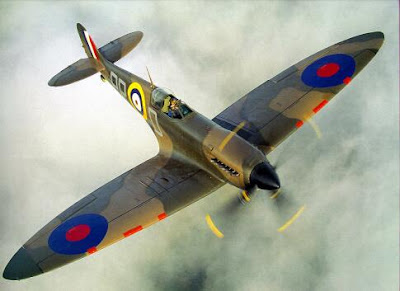We who linger at airports and mess about with airplanes will occasionally, when grounded by weather or mechanical misfortune and forced to settle for hangar flying, resurrect and recycle the everlastingly interesting discussion that seeks to name "The Most Beautiful Airplane Ever Built". I think that the question is misguided. It seems to me infelicitous to force comparisons of relative aesthetic merit between radically differing types. My thought is to award four "Most Attractive" trophys to the Best of Breed in these categories: Single Engine Prop; Single Engine Jet; Multi-engine Prop and Multi-engine jet. As you might expect, I have opinions that I'm willing to share.
In starting with single engined propeller-driven airplanes, I immediately encounter a problem. I've never been able to settle on one exemplar to regard as the Prettiest Bird. In this category, I have to settle for a tie. On one hand there is Reg Mitchell's immortal Spitfire. For anyone who has studied aerodynamics, the perfection of the Spit's elliptical wing planform cannot help but make the heart beat faster. And all of her other lines flow harmoniously into that wonderful wing.
But on the other hand, Walter Beech's beautiful D-17 Staggerwing biplane clamors for attention. The genius of that reverse decalage inspires awe. It was agile, it was fast and above all, it was gorgeous! By all accounts, the Staggerwing has a nasty bite on the ground but any vices have to be forgiven in the presence of such beauty. (And, it's the only one of my "Beautiful Birds" that I can even dream about actually flying someday.)
So there I'm left, Staggerwing or Spitfire. Which is the more beautiful? I can't say - you decide.
When we turn to jet-propelled aircraft, life is easier. Think about single-engined jets and the grace and cleanliness of line offered by the Sabre, product of Ed Schmued's team at North American, come immediately to the fore.
The early versions of the design were straight-winged, like a P-80 or an F9F. But North American's designers were exposed to the research product of the German aerodynamicists and they understood what to do. The lovely, clean swept wing of the Sabre emerged. Other fighters have come along that will outperform the F-86 by a wide margin, but none exceed her beauty (though the Hawker Hunter comes close).
Turning to multi-engined aircraft, and starting with propeller-driven designs, there is in my mind only one answer. My friend Dennis Wolter, a profoundly talented industrial designer, said it well when he told me, "The Lockheed Constellation is the most beautiful industrial artifact ever created by man." The triple-tail, the gentle dolphin-curve of the fuselage, the slender wing supporting the four powerful Wright R-3350's are iconic and incapable of duplication. The Connie of my youth will always be, for me, the Angel of the Airways.

Again leaving behind propeller generated thrust and turning to jets, it is once more an early design (as the Sabre was) that embodies best the natural beauty enforced by natures laws of fluids. What could be more pleasing than the form of Boeing's Stratojet, the B-47? Pilots who had to fly it in defense of our nation will tell you that she was a bitch. Underpowered, and harboring lurking aerodynamic vices, the Stratojet insisted that you be on top of your game and imposed a terrible penalty if you were not. But was she not so very beautiful?
For a good number of years, that's been my take on the "Most Beautiful Airplane" question. Spit or Staggerwing for piston singles, the Sabre for a single engined jet, the Connie for the multi-engined prop and the Stratojet for a multi-engined jet. Many designs have come along, none have prompted me to change my judgement. Most certainly, the utilitarian but (in my view) unlovely A380 has no claim on exceptional beauty or grace.
But recently...in fact, yesterday...things may have changed. Yesterday, the Boeing 787 took to the sky for the first time. And she is such a beauty!
I submit that this is one really gorgeous airplane. Look at the arc of the composite wing under the force of lift. It brings to mind some great-spanned albatross gracefully alighting - or perhaps an owl swooping down over a field to snatch up a wayward vole. This image says to my heart, "Here is a creature of the sky." Many airplanes can be made to fly; this airplane belongs in the sky. Many years ago my aerodynamics professor, Dr. Jack Werner, said to us, "Don't trust an ugly airplane." His point was that nature imposes an aesthetic, and the greatest flying machines work in concert with that aesthetic and never in contravention of it. I feel that the 787 would have pleased him.
The Boeing design team deserves rich congratulations. After a troubled gestation we may find that, in their Dreamliner, they have wrought a classic. And if the B-47 Stratojet is to be displaced as the Most Beautiful Airplane in the multi-engined jet class, it's fitting if the Dreamliner, a product of the "home team", turns out to be its successor.







































